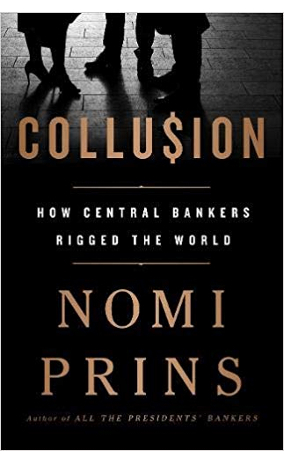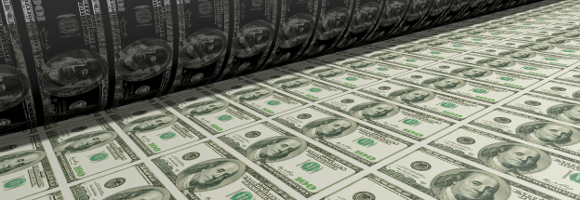
Reflections on Vancouver, British Columbia and other topics, related or not
“The money-conjurers”
Only a radical reset can solve the
central bank problem, says Nomi Prins
Greg Klein | July 3, 2019
Collusion: How Central Bankers Rigged the World
by Nomi Prins
Imagine the power—unchecked power, at that—to create money. Then imagine the disaster such power could unleash. While that scenario looms in the foreseeable future, Nomi Prins argues, its precursors have made themselves obvious since 2008. They’re the result of central bank policies and the system that sustains them, institutions absolutely bereft of a Plan B. A mess so manifestly dangerous calls for radical solutions, she maintains.
That’s the perspective of an insider, or at least an ex-insider. A veteran of Lehman Brothers, Bear Stearns and Goldman Sachs, Prins dedicated herself “to exposing the intersections of money and power and deciphering the impact of the relationships between governments and central and private bankers on the citizens of the world.” Six books later came Collusion, recently released in paperback.
This is a work of extensive detail, recounting who did what to interest rates, inflation rates, currency valuations and other economic interventions, focusing on quantitative easing and the other euphemisms for her preferred term: “money conjuring.” Collusion also answers a key question: Cui bono?
Faced with the sub-prime crisis,

The US government and Fed reacted by subsidizing private banks (in particular, the Big Six US banks that were key toxic asset creators). The Fed fashioned an historic bailout program that invoked zero interest rate policy (ZIRP), initiated a strategy of quantitative easing by which the central bank fabricated money to purchase government bonds and other securities, and created massive lending programs for banks with relaxed collateral rules. The Fed coerced central banks worldwide to adopt similar strategies.
With little or no trickle-down effect, she emphasizes. If the too-big-to-fail rationale claimed to protect the wider economy, the wider economy didn’t notice. Through share buy-backs and other strategies, banks used the largesse to enrich themselves instead of providing loans or investments that would put more people to work. G7 banks also used conjured money to “speculate globally, especially in developing countries, in markets rather than in direct economic investment that benefited populations.”
Only in isolated incidents were malefactors called to account. That happened in late 2016, for example, when the U.S. Justice Department hit European Central Bank beneficiary Deutsche Bank with $7.2 billion in fines “for crimes committed during the financial crisis—a sign of all that conjured-money policy had plastered over…. All the cheap-money subterfuge had not addressed the prevailing and alarming codependencies among too-big-to-fail banks the world over. That meant systemic risk had not been extinguished, it had only been camouflaged. The fine was just that, a fine, not a shift to prevent any of the looming hazards the financial system could still unleash.”
Facing even less scrutiny than private banks are central banks, rarely required to explain their machinations. “They vacillate between taking credit for what they deem are positive results in the world economy and remaining silent in the wake of catastrophic failures that result from their policies.”
While G7 central banks collaborated with the Fed, some of their G20 counterparts resisted. Regardless, globalization globalized America’s crisis. But despite U.S. efforts to reinforce world influence, the country inadvertently helped China rise to second-greatest economy status with a currency that challenges dollar supremacy. Contributing to the Middle Kingdom’s stature were some emerging economies, distrustful not only of America’s ambitions but its economic stability.
Current and future stability, more than past misconduct, remains Prins’ greatest concern:
“The Fed has allowed the biggest banks on Wall Street to essentially double the risk that devastated the system in 2008.”
She attributes to manufactured money a global debt equal to three times global GDP, a peril that could itself crash the economy or seriously aggravate a crisis of geopolitical origin. As for solutions, she insists that desperate times call for very desperate measures:
“We could write off all the public debt incurred since 2008 that hasn’t been redirected to the real economy—that is, take a deep breath and cancel it out globally.”
Prins also advocates oversight of the money-conjurers, as well as forcing them to channel their money into constructive investments. She wants the big banks dismantled “so that they can’t hold people’s deposits hostage during the next crisis.”
But, assuming her proposals are sound, where’s the will to carry them out? She depicts G7 countries and central banks as stuck in conventional attitudes and clinging to privilege with no impetus for reform. Emerging economies, meanwhile, might be watching with cautious detachment. China, quite likely, looks on expectantly.
